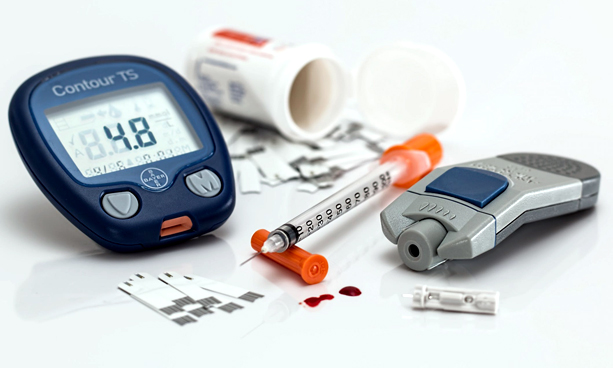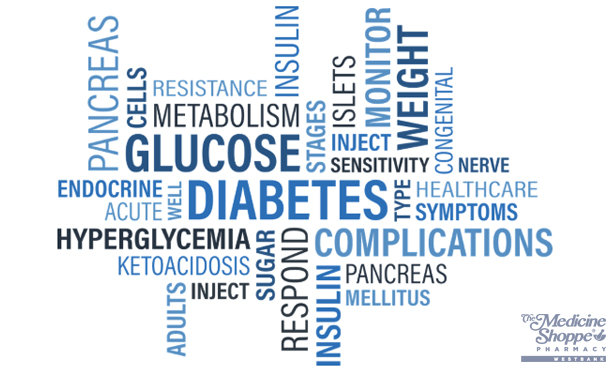What is diabetes?
Facts about diabetes: Behind the stomach is an organ that most people don’t often think about: the pancreas. In a healthy body, the pancreas releases a hormone called insulin when the level of sugar in the blood gets too high. Insulin causes cells to take in the sugar — either to use as energy or to store as fat. This results in blood sugar levels going down. Another hormone, glucagon, works with insulin to control blood sugar levels.
Without insulin, sugar builds up in the bloodstream which can lead to serious health problems. These include heart disease, blindness, nerve damage, erectile dysfunction, stroke, foot problems, and kidney problems. Diabetes is a chronic disease in which the body either cannot produce insulin, or it cannot properly use insulin.
If you have type 1 diabetes, it means that your body doesn’t produce insulin. If you have type 2 diabetes, your body produces insulin, but can’t use it properly.
How many people have diabetes? And who gets it?
There are 11 million Canadians with diabetes or pre-diabetes. Type 2 is the most common type. About 9 out of 10 people have type 2.
Scientists think that type 1 diabetes occurs because your immune system mistakenly kills the cells in the pancreas that produce insulin. Why this happens is currently unknown.
Type 1 diabetes is not caused by your diet and it isn’t preventable. There is a genetic factor and if you have a parent or sibling with type 1 diabetes, you are at slightly higher risk of having it yourself. Beyond that, the risk factors are unclear. Type 1 is usually diagnosed in childhood or adolescence, but it can develop in adulthood.
Type 2 diabetes usually develops in adulthood, but can be diagnosed in children too. Your risk of developing type 2 diabetes is higher if you:
- Are age 45 or older
- Are not physically active
- Have a parent or sibling with diabetes
- Had gestational diabetes during pregnancy, or gave birth to a baby that weighed over 4kg/9lbs at birth
- Have high blood pressure
- Have high cholesterol
- Are overweight or obese
- Have polycystic ovary syndrome (PCOS)
- Have schizophrenia, depression, or bipolar disorder
- Have been diagnosed with obstructive sleep apnea
- Are of African, Arab, Asian, Hispanic, Indigenous, or South Asian descent
What is type 1 diabetes?
If you have type 1 diabetes this means that your pancreas does not make insulin. Without insulin, sugar builds up in the blood, instead of getting into cells to be used for energy. Type 1 diabetes is always treated with insulin. If you have type 1 diabetes, you will need to start taking insulin right away, and take it every day for the rest of your life. Meal planning can help to keep blood sugar at the right level.
What are the symptoms of type 1 diabetes?
Sometimes, the first sign that someone has type 1 is diabetic ketoacidosis (DKA). DKA is a life-threatening condition. If you or your child has symptoms of DKA, call 911 or head to emergency.
Symptoms of DKA include:
- Fruity smelling breath
- Hot, dry, flushed skin
- Loss of appetite, nausea, vomiting
- Blurred vision
- Rapid, deep breathing
- Stomach pain
- Trouble breathing
- Confusion, or trouble paying attention
- Drowsiness
- Feeling thirsty and urinating a lot
When DKA is severe, it must be treated in hospital, often in intensive care. Treatment involves insulin and fluids being given through a vein. Chemicals in the blood will be closely monitored. Care providers will also keep an eye on the patient’s brain to make sure it doesn’t swell from the treatment for dehydration. It can take a few days for blood sugar levels to return to an acceptable level.
Although some people discover that they have type 1 diabetes because they experience DKA, sometimes the symptoms are more subtle.
Type 1 diabetes symptoms may include:
- Increased thirst
- Frequent urination
- Increased hunger
- Tiredness
- Weight loss
- Slow-healing sores
- Dry, itchy skin
- Numbness or tingling in the feet
- Blurry vision
If you have these symptoms, talk with your doctor. A blood test can show if you have the diabetic condition.
How is type 1 diabetes managed?
 Everyone with type 1 needs to use insulin. You can’t take insulin in pills because it would be destroyed in your stomach and be unable to work. This is why insulin must be injected.
Everyone with type 1 needs to use insulin. You can’t take insulin in pills because it would be destroyed in your stomach and be unable to work. This is why insulin must be injected.
There are several different types of insulin. They differ in how quickly they start to work, how long their effects last, and when they are most effective. You may need to use more than one type of insulin to manage your blood sugar levels effectively. By understanding how your prescribed insulin works, you will be better able to time your meals, snacks, and physical activity. You can take insulin with a syringe and needle, an insulin pen, or an insulin pump.
Insulin pens are loaded with a cartridge containing insulin, in precisely the correct amount you need. If you need two types of insulin, you will need separate pens, and if you need the two types of insulin at the same time, you will give yourself an injection from the two different pens.
Syringes allow you to mix different types of insulin together if you need them at the same time, and you can give yourself only one injection. Premixed formulas may also be available.
Insulin pumps are often used by people who need multiple insulin injections every day. A pump is a small battery-operated device worn outside the body and is attached to a catheter, which is inserted under the skin.
Diabetes Canada has some YouTube videos on how to inject insulin, and how to use an insulin pen. Click here to visit their channel and search for ‘insulin’.
You can talk with your doctor, and you can also talk with one of us at Medicine Shoppe Westbank about which method of taking insulin is best for you.
Checking blood sugar levels
 To know how much insulin to take, and when to take it, you need to check your blood sugar levels regularly. This will also help determine if you’re managing your diabetes well and keeping your blood sugar levels within their target range.
To know how much insulin to take, and when to take it, you need to check your blood sugar levels regularly. This will also help determine if you’re managing your diabetes well and keeping your blood sugar levels within their target range.
A blood sugar monitor requires a tiny drop of blood, which is usually taken from your fingertip, after you have washed your hands with soap and water. (Use warm water to increase the blood flow to your fingers and make it easier to obtain the blood sample.) You will use a lancet with a spring-loaded needle to do this.
The needles are extremely fine, so testing is almost pain-free. A lancet that allows you to adjust the depth of the puncture also helps to minimize any pain. Deeper punctures are more painful because you touch more nerves. So adjust your lancet to the shallowest setting that also gives an adequate blood sample.
Obtaining the drop of blood from the side of your fingertip, rather than from the centre, also helps to minimize the pain. This is because the sides of your fingers have fewer nerve endings, and more blood vessels. Using a different finger for each sample will also help minimize pain.
To prevent bruising, after you’ve taken the sample, firmly press a clean tissue to the site for a few seconds until the bleeding stops.
What is type 2 diabetes?
If you have type 2, either your body can’t properly use the insulin that is released by your pancreas, or your pancreas doesn’t make enough insulin. This means that sugar builds up in your bloodstream instead of being taken in by cells to be used as energy.
Depending on how severe your type 2 diabetes is, you may be able to manage it by increasing physical activity and making changes to your diet. But this may not be enough, and you might need to take medications and/or insulin to control your blood sugar levels. Type 2 diabetes is a progressive condition, and many people eventually need to use insulin to manage their blood sugar levels.
What are the symptoms of type 2 diabetes?
The symptoms of type 2 diabetes can appear gradually, and can be hard to notice. The symptoms can include:
- Increased thirst
- Frequent urination
- Increased hunger
- Weight loss
- Tiredness
- Blurry vision
- Slow-healing sores
- Frequent infections
- Patches of darkened skin
How is type 2 diabetes managed?
Some people with type 2 need to inject insulin, just as those with type 1 need to. Please see the information above on injecting insulin and checking your blood sugar levels.
If your diabetes is not severe, you may be able to manage it by making changes to your diet and activity levels. However, you may need to take diabetic pills. (Bear in mind that it is not safe for pregnant women to take oral diabetic medications.) Most people with type 2 diabetes who take oral medication find that their blood sugar levels decrease, but they may not go down low enough.
Metformin is a commonly prescribed drug for management of type 2 diabetes. It works by making your body more sensitive to insulin so it can make better use of it. Common side effects are nausea, vomiting, and diarrhea, but these will likely improve after taking the medication for a while. If you are concerned about side effects, or would like to talk about other possible medications, talk to your doctor or pharmacist.
____________________________
Article contributed by: Zena Ryder
Sources:
Diabetes Canada: www.diabetes.ca
American Diabetes Association: www.diabetes.org
Medline Plus: www.medlineplus.gov
National Institute of Diabetes and Digestive and Kidney Diseases: www.niddk.nih.gov
Health Canada: www.canada.ca/en/health-canada.html
Health Link BC: www.healthlinkbc.ca
Mayo Clinic: www.mayoclinic.org

